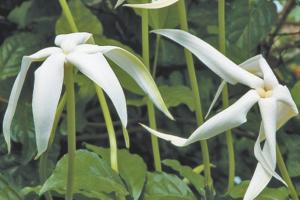Only prune Angel of the Night after blooming
They are spiritual beings more powerful and far more intelligent than humans. They can be kind, helpful and downright benevolent or angels can be not so nice. They have great wisdom but are not infallible. These are the angels among us.
Angels have specific jobs such as messengers between heaven and earth, or as protectors or guardian angels. But why stop there? There are Redeemer Angels who redeem you and angels that hold our hands and guide us through the night, angels of the night.
The garden has its own Angel of the Night (Randia ruiziana), a radiant pure white pinwheel flower with possibly the sweetest, most fragrant flowers of any houseplant. These long, tubular blooms can reach 8 inches long with five pointed petals that slowly bend to form the stunning pinwheel.
Angels often bring healing, and Carl Linnaeus gave Randia ruiziana the name Randia to honor fellow botanist and apothecary Isaac Rand, the director of the Chelsea Physic Garden.
Angels come when you need them, not when you call them. The fragrant Angel of the Night blooms for right in the dead of the winter and stays in bloom for several months.
Angels are fragile and Angel of the Night will die in anything colder than USDA Hardiness Zone 10. Luckily they make great houseplants, with the airy, open branching South American native growing well in moderate light. Of course more light is better, so if you can supplement the winter light with a grow-light for a total of 12 hours of light per day.
Pot up Angel of the Night in pots at least 18 inches wide and 20 inches tall. Be sure your pots have drain holes. Keep in mind that terracotta pots are more porous than glazed pots so will need to be watered more often. Use a good, well-draining potting soil. Randia ruiziana does not do well if its roots remain wet.
Add some sand to your soil to improve drainage. When you water your “angels” think heavenly shower, not deluge of the damned. Lightly water the soil until water drains out of the base of the pot.
Let the top few inches of soil dry out before you water again, probably in a week or more. If you have lots of light, good humidity and ideal conditions you may have to water more often.
Angels don’t eat much, and Angel of the Night are just moderate feeders. You can help them along with a slow release liquid fertilizer intended for flowering houseplants, diluting it to half strength.
Angels are timeless but some wait to show off until late. Only prune Angel of the Night after blooming or you may cut off next year’s flowers.
Youth has its place, but Angel of the Night only blooms on old wood.




















































